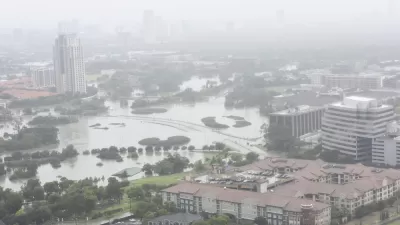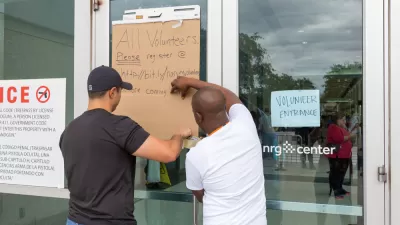The Guardian's former environmental editor asks if urban sprawl is as much to blame as climate change for the flooding caused by Hurricane Harvey in Houston.

As of Sept. 5, the death toll caused by Hurricane Harvey, which made landfall near Corpus Christi, Texas on August 25, was 60 according to The Washington Post. In South Asia, over 1,400 people lost their lives to unusually powerful monsoons. John Vidal, the Guardian's former environmental editor, points to Africa which has also recently experienced great loss of life due to monster storms.
"So what is to blame for these severe weather events and some of the worst flooding ever seen?" he asks.
Climate scientists agree that extreme rainfall will increase as the world warms. Other researchers argue that poor urban infrastructure and the rapid, unchecked sprawl of cities on to marshlands and other places that usually absorb excess rainwater have led to flooding.
“We know climate change is influencing the capacity of the atmosphere to hold water but it is hard to attribute this to individual [flooding] events,” says Paolo Ruti, head of the global weather research division of the UN’s World Meteorological Organisation (WMO) in Geneva.
No such reservations on the cause of the extreme flooding experienced by Housto are held by Sam Brody, a Texas A&M University marine researcher with a Ph.D. in City and Regional Planning, University of North Carolina, Chapel Hill, who specialises in natural hazards. Brody was also interviewed by CityLab in our first post on Harvey.
[He] believes the addition of more than 1 million people moving to flood-prone areas near Houston since 2000 has overwhelmed the city’s ability to drain water.
The Texas coastal climate is changing, the sea level is rising and there are more heavy downpours, says Brody, but the key factor in the flooding is development in unsuitable areas.
“If you are going to put 4 million people in this flood-vulnerable area in a way which involves ubiquitous application of impervious surfaces, you’re going to get flooding. The driving force is the built environment,” he says.
Billy Fleming, research director for the Ian L McHarg Center at the University of Pennsylvania School of Design, where he earned a PhD in City Planning, writing for the Guardian casts blame on people as well as policies.
Houston’s unfettered sprawl into the marshland of southeast Texas was a conscious choice by policymakers...The swamps and wetlands that once characterized Houston’s hinterland have been replaced with strip malls and suburban tract homes.
Those landscapes once served as a natural flood protection system for the city. Research shows that, if they hadn’t been filled and developed, Harvey’s impact would have been lessened. Sam Brody and his colleagues at Texas A&M University in Galveston have been predicting an event like this for nearly a decade. That their work went unheeded by Texas policymakers should not be forgotten.
An earlier post looked at how Houston's lack of zoning may have contributed to the flooding. Researchers instead found fault with sprawling development patterns and a lack of regional planning.
"In Harris County alone, research by Texas A&M scientist John Jacob shows, almost 30 percent of freshwater wetlands were lost between 1992 and 2010, a figure he calls 'unconscionable.'" [ProPublica: "Boom town, flood town: How Houston's development increases flood risk," Dec. 7, 2016]
As for the category 5, Hurricane Irma, packing 185-mph winds, CNN reports on Wednesday that it has destroyed "nearly 90% of Barbuda", located in the middle of the Leeward Islands in the Caribbean. And what of it coming just days after the category 4 Hurricane (now tropical depression) Harvey?
Ruti of the WMO adds, “The frequency of hurricanes and tropical storms is not changing, but we must get more and more used to these events.”
Hat tip to Fred Heutte.
FULL STORY: As flood waters rise, is urban sprawl as much to blame as climate change?

Alabama: Trump Terminates Settlements for Black Communities Harmed By Raw Sewage
Trump deemed the landmark civil rights agreement “illegal DEI and environmental justice policy.”

Study: Maui’s Plan to Convert Vacation Rentals to Long-Term Housing Could Cause Nearly $1 Billion Economic Loss
The plan would reduce visitor accommodation by 25% resulting in 1,900 jobs lost.

Planetizen Federal Action Tracker
A weekly monitor of how Trump’s orders and actions are impacting planners and planning in America.

Wind Energy on the Rise Despite Federal Policy Reversal
The Trump administration is revoking federal support for renewable energy, but demand for new projects continues unabated.

Passengers Flock to Caltrain After Electrification
The new electric trains are running faster and more reliably, leading to strong ridership growth on the Bay Area rail system.

Texas Churches Rally Behind ‘Yes in God’s Back Yard’ Legislation
Religious leaders want the state to reduce zoning regulations to streamline leasing church-owned land to housing developers.
Urban Design for Planners 1: Software Tools
This six-course series explores essential urban design concepts using open source software and equips planners with the tools they need to participate fully in the urban design process.
Planning for Universal Design
Learn the tools for implementing Universal Design in planning regulations.
Caltrans
Smith Gee Studio
Institute for Housing and Urban Development Studies (IHS)
City of Grandview
Harvard GSD Executive Education
Toledo-Lucas County Plan Commissions
Salt Lake City
NYU Wagner Graduate School of Public Service





























